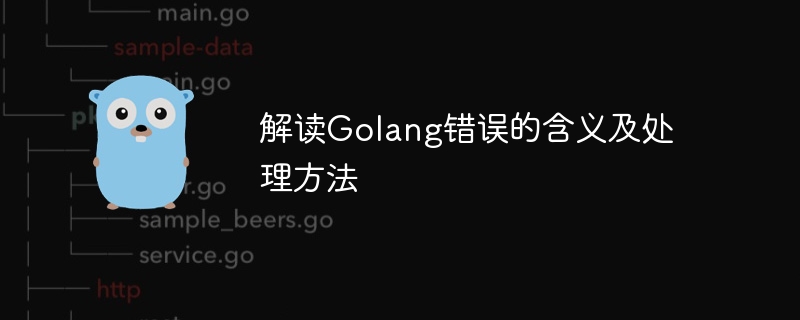

Golang is a fast, concise, and efficient programming language, but it is inevitable to encounter various errors in actual development. Understanding and handling errors correctly is an important part of writing robust programs. This article will delve into the meaning of Golang errors and how to deal with them, and will provide specific code examples.
In Golang, errors are represented as a type that implements the error interface. error The interface is defined as follows:
type error interface {
Error() string
}Any type that implements the Error() method can be used as an error. Normally, when a function encounters an error, it returns a non-null error value.
In Golang, common ways to handle errors include: if err != nil, panic, defer and recover etc.
if err != nil Handling errors The most common error handling method is to use if err != nil for judgment, for example:
if err != nil {
return err
} raises an error panic The function actively raises an error, for example:
and recover to recover errorsdefer and recover together to recover errors, for example:
package main import ( "errors" "fmt" ) //Define custom error type type CustomError struct { errorCode string } func (e *CustomError) Error() string { return fmt.Sprintf("Custom error: %s", e.errorCode) } func main() { result, err := divide(10, 0) if err != nil { fmt.Println("An error occurred:", err) } else { fmt.Println("result:", result) } } func divide(x, y int) (int, error) { if y == 0 { return 0, errors.New("The divisor cannot be zero") // You can also use custom errors // return 0, &CustomError{errorCode: "DIV_ZERO"} } return x / y, nil }
CustomError type to represent custom errors. In the divide function, a specific error message will be returned when the divider is zero.
To summarize, in Golang, it is very important to correctly understand and handle errors. By using the error interface, if err != nil judgment, panic raising an error, defer and recover recovery Error and other methods can effectively handle various error situations and improve the stability and reliability of the program.
The above is the detailed content of Interpret the meaning and handling of Golang errors. For more information, please follow other related articles on the PHP Chinese website!
 How to define variables in golang
How to define variables in golang
 What are the data conversion methods in golang?
What are the data conversion methods in golang?
 What are the commonly used libraries in golang?
What are the commonly used libraries in golang?
 What is the difference between golang and python
What is the difference between golang and python
 bios cannot detect solid state drive
bios cannot detect solid state drive
 cookie
cookie
 Why the computer keeps restarting automatically
Why the computer keeps restarting automatically
 The m2m concept in the Internet of Things
The m2m concept in the Internet of Things




